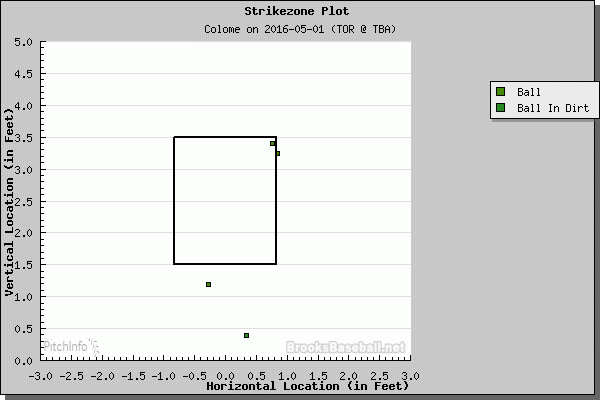One At-Bat is a thing I do around here. I usually take one critical plate appearance from the recent past, and I break it down pitch by pitch. I do that in order to offer insight into just how thin the line is between victory and defeat on any given night. Any given day, too, I guess. Sometimes, though, it isn’t One At-Bat. The one swing that looks dramatic and important isn’t really the key, it’s just the exclamation point on a long sentence of improbable events.
The reason, naturally, that I bring this up, is that while searching for my next OAB breakdown, I found such a confluence of events. Sunday afternoon, May 1st, at Tropicana Field, the Blue Jays and the Rays entered the top of the 9th inning tied 1-1. Interestingly, each team had a win expectancy of 50% at that point. It was literally anybody’s game to win. By the end of the half inning, the Rays will have a 1.5% chance of winning the game, and it all starts with Darwin Barney.
The Setup:
Not a lot of stories start with Darwin Barney, so that’s significant right there. In this case, Barney, who hits from the right side, has been called upon to pinch hit in Ryan Goins’ spot, as the Rays lefty Xavier Cedeno is pitching to start the ninth. It’s the natural call for John Gibbons to make, as righties gain about 70 points of AVG and 90 points of OBP versus Cedendo.
With that said, Darwin Barney is a glove first player, and has a career OBP against lefties of .322 (close to league average) and a SLG% of .384 (not even close to average). Darwin Barney also hits doubles at the rate of one every 21.42 plate appearances (just below league average). However, on the second pitch of his at-bat, Darwin turns on an inside cutter at 87mph.
It lands fair in the left field corner and he chugs into second base standing up. The first link in the chain is formed.
The Sequence:
Michael Saunders comes up, and it’s obvious from pitch number one that he’s bunting. John Gibbons is playing to score one run, sacrificing an out to get Barney to third. Cedeno remains in the game, as the lefty/lefty matchup favours him. Even though the bunt is on everyone’s mind, Xavier misses low, or low and away four times in a row. Instead of one out, Saunders walks down to first. Nobody out, two on, and the right handed power core coming up for Toronto means it’s time for a pitching change. The second link in the chain is in place.
Alex Colome is the new pitcher, and he doesn’t start off well against Donaldson. He throws 95mph, misses low, and then buries his second pitch in front of home plate. Then something a little bit lucky happens: the umpire, perhaps unimpressed with the wildness he’s seen, calls the next two pitches balls as well. Let’s see where they actually tracked.
Under normal circumstances the zone usually expands when the hitter is ahead, but apparently, not this time. So, instead of 2-2, which is a tough count to hit in, the Blue Jays have the bases loaded and nobody out. In terms of win expectancy, Barney’s double raised the Jays chances by 17.3%, Saunders’ walk by 2.5%, and Donaldson’s walk 14.5%. The Jays haven’t had a runner cross the plate, but the likelihood of multiple runs in the inning is so high that the Jays have an 84.3% chance of winning the game at this point.
This is why I love baseball. You know what should happen. You know what probably will happen. You can even see it happening in your mind. But it hasn’t happened yet. Colome might wriggle out of the chain.
The next batter up is Jose Bautista. Something you may have not noticed about Jose: in this particular situation, and by that I mean with the bases loaded, he’s not very good. His career slash line, as a point of reference, is .257/.369/.498. With the bases loaded, he bats .222/.317/.411. That’s a big dropoff. Oddly, if you take the runner off of first base, Jose has a .432/.559/.704 career slash line. Mental block? Not sure, but if you want somebody up with the bases loaded and the game on the line, it’s probably not Jose.
True to form, Jose starts chasing on the 4th pitch of the at-bat, and chases himself back into the dugout with a swinging strikeout on the fifth. The Rays get 12.4% of their win probability back. There is a mark on the chain, but it’s going to take a lot more effort to break it.
Edwin Encarnacion is up next. The very first pitch is hit for a sharp grounder up the middle. In another time and place, it’s a double play and the inning is over. The Blue Jays, however, are forging a chain out of luck and hope here. Somehow, with the infield shifted around and pulled in, the second baseman fields the ball on the shortstop side of the bag. Take a look.

When he does that, the shortstop doesn’t have time to cover second base. With nobody to throw to the only out to be had was at first base. I don’t know how that wasn’t a double play. The odds of a grounder fielded by the second baseman are low. Those odds with two slow runners on the base paths? Even lower.
Encarnacion’s fielder’s choice is worth 13.6% in win expectancy. Incredibly, it’s only the third highest change in the win probability in this inning. Some games finish without a single plate appearance affecting the outcome by that much.
The Payoff:
I call it “The Payoff” here because it’s what we all want; a big moment to stamp in our memories. So, let’s walk through it, have some fun, and then go back for another look.
Troy Tulowitzki. Two men on. Two men out.
Pitch One – Away, ball one.
Pitch Two – High, ball two.
Pitch Three – Low, outside corner, strike one.
Pitch Four – Upper third of the zone, outer third of the plate. Swing and a drive.

And that, folks, is how you give up the 198th home run of Troy Tulowitzki’s career. The Win Expectancy needle moves 13.1% on that play. It’s hard for it to move much further, as the Jays now have a 98.5% chance of sealing the victory in the bottom of the 9th.
Can I point to one critical moment in this inning? No, I only have so many fingers on my hand. It began with an unlikely double. And, by win expectancy, that double was the most important play in the inning. It continued with a four pitch walk that should have been a sac bunt. Another four pitch walk was a gift from the umpire. Then a strikeout. Then an easy groundout that wasn’t a double play. Finally, the big blow: a home run from Tulowitzki (who hasn’t looked like himself since he became a Blue Jay). Maybe the Trop isn’t the ‘house of horrors’ that we make it out to be. Perhaps instead it’s just where bizarre baseball comes to play.
Lead Image- Kim Klement-USA TODAY Sports



The thin line in this inning would seem to be EE hitting the grounder where he did instead of maybe 6-10 feet toward either side.
As I recall, Colome only threw one pitch in the zone to JB who helped strike himself out by expanding his strike zone not once but twice. So, another thing that was odd / uncharacteristic.